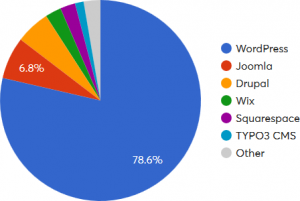Which is the most popular CMS available?
Which is the most popular CMS available? Content management systems (CMS) have gone a long way since they were initially created. Most CMS available today were originally built for blogging purposes. As they improved businesses started to use them for managing their website and now CMS are used for almost any purpose.
Content management systems come in all shapes and sizes, some are widely used to manage brochure style websites, others used for shopping carts and CMS can now be used for custom applications such as booking systems, customer relationship management systems and much more. Below we are covering the top 5 most popular CMS available. Before we dig deep lets look at what Wappalyzer tells us about which is the most popular.
Wappalyzer Data
Wappalyzer is a utility that uncovers the technologies used on websites. It detects content management systems, eCommerce platforms, web frameworks, server software, analytics tools and much more. For this topic we are using the latest data that helps us to understand which is the most popular CMS available.
Out of the 211 CMS analysed the latest statistics show that the top 5 most popular CMS available are;
- WordPress accounts for 78.6% of CMS used world wide
- Joomla came in at 6.8%
- Drupal at 4.3%
- Wix 2.4%
- Squarespace at 1.9%
WordPress being the market leader is a free open source CMS that has been around as long as content manged websites were originally developed. WordPress originally started as a blogging tool and quickly grew into a popular CMS for small businesses as the framework built around WordPress made it easy for a website owner to manage their website once it had been built. Since it was originally developed WordPress has come a long way and now can be used for almost any online application including content management systems for brochure style websites, shopping carts, web applications, booking systems, customer relationship systems and much more. Due to the huge popularly of WordPress most online services will have a plugin available to syncronyse your data with theirs. To name a few, MYOB, Zoho, Salesforce, Hubspot and FreeAgent all have a plugin available to connect with WordPress.
Joomla also a free open source CMS and was originally the number one content management system to use. Almost all websites that we built 2005-2010 were built using Joomla. It ruled over all other content management systems for quite some time though over the past 5-6 years it has slowly lost momentum due to the introduction of more than 100 other content management systems on the market and the explosive growth of WordPress. Joomla is still a widely used CMS though they have a lot of catching up to do. Joomla is still used though it would normally be selected for a particular client wanting to use it for their own reason.
Drupal again a free open source CMS that accounts for 4.3% of the websites online today though it is no longer considered a CMS used for small business websites. Drupal is now mainly used by larger organisations due to its ability to manage complex and highly dynamic web properties that create seamless experiences for its users. WordPress has absolutely conquered the small website and small business market though Drupal still holds strong with lager organisations though thsi will come at a cost.
Wix & Squarespace combined account for almost 5% of the websites used today. Both of these are proprietary content management systems, this meaning that you pay on a monthly basis to rent their CMS. Both have spent millions in advertising campaigns though they struggle to gain momentum. Both are targeted towards the D.I.Y market and come with dirt cheap start up costs though you generally find that as you want to add options, features or syncranise with other frameworks the costs rise dramatically making them not the cheapest options available. This defeats the purpose of the D.I.Y market as the website owner wants to save a few dollars. With D.I.Y CMS you either use what they offer at the cheaper prices or pay hefty month fees to achieve what you could have done with an Open Source CMS. Either way there is a market for D.I.Y websites so they will always be on the list of top 5.
Final Thoughts
There will always be a need for proprietary (paid) based CMS however the nature of the options available for open source content management systems is causing proprietary based CMS to become less appealing. Proprietary CMS loose the customer very quickly when they lose in the ability to add features as easy as they would with open source. As of which is the most popular CMS available, WordPress hands down at 78.6% of the market.
Want to learn more? Read our Open Source vs Proprietary CMS. Which Is Best? article.














